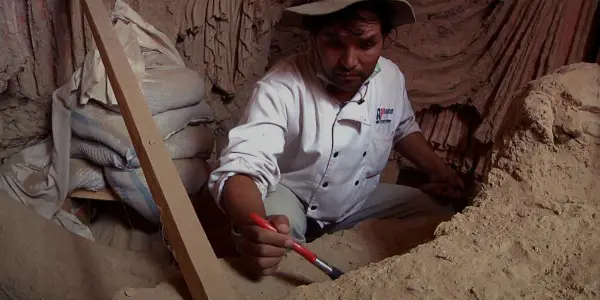Documentaries, as with the reality from which they are culled, typically occupy the realm of ambiguity. Not even getting into the arguments about objective truth in filmmaking, the subjects of documentary films are real people, and thus come with all the foibles and shades of grey inherent in our species. This is in stark contrast with most narrative films, which have been recycling the archetypes put forth by Joseph Campbell for as long as they’ve been produced. So when a documentary is able to co-opt narrative storytelling tropes and affix them to its representation of reality, the result can be quite effective.
That is definitely the case with Saving Mes Aynak, which takes the tried and true plot of Breakin’ 2: Electric Boogaloo, and supplants the local community center with a 5000-year-old archaeological site, and the greedy real estate developers with a greedy Chinese mining company. The film’s central figure, Qadir Temori, is an Afghan archaeologist more Don Quixote than Indiana Jones, fighting extraordinary forces from all sides that threaten to wrench from him and his country what his colleagues around the globe are deeming the most significant find of the century.
Under Attack From All Sides
Saving Mes Aynak has the unenviable task of making the slow, detailed work of archaeology not only visually interesting, but narratively appealing, and at both efforts the film succeeds with apparent ease. Working within a brisk 60-minute runtime, it wisely devotes sufficient time to presenting some of the dig’s most impressive findings to date, including carvings of wood, a rarity among ancient sites of this kind which indicates the high level of natural preservation at the site. Temori and his team estimate that only 10% of the site has been revealed thus far, requiring years, maybe decades, to unearth it all.
What they have, however, is exactly 1 year. This is due do a deadline foisted upon them by the Afghan Ministry of Mines, which is supplying the majority of the labor for the project, while at the same time brokering the deal with Chinese Fortune 500 company MCC to build an open pit copper mine on the ancient site. Thousands of years of unprecedented preservation would be cast aside for short term financial gains and one offensively large hole in the ground. Furthermore, Afghanistan would stand to benefit from only about 1% of the mine’s projected output, making the argument that the mine is in the best interest of its economy and populace a flimsy one.

As if that weren’t enough, Mes Aynak lies close to the border with Pakistan, and the site is under constant guard against potential Taliban attacks, who see the largely Buddhist site as an affront to Islam. Live landmines litter the area. Compounded with a half-fulfilled commitment from the international community to provide badly needed resources and expertise, Qadir seems to persevere on passion alone, and that sentiment passes through the lens to the viewer, leaving one at once enthralled and exasperated.
To achieve this, director Brent E. Huffman eschews any strict documentary formalism and employs a variety of techniques to best communicate the gravity of Qadir’s predicament. Combining verite footage, talking head interviews, news clips and internet videos, Huffman submits himself to the service of the natural narrative baked into his subject, though not to discount the careful editing in making said narrative evident and powerful.
Conclusion
Documentary filmmaking is a delicate tightrope, curating life while attempting to represent some kind of reality. It is often an art of highlighting and embellishing; whether a bearded hot sauce maven, anti-union coal workers or a machine-politics incumbent mayor, the filmmakers that cast them as villains need only to edit away anything that might counter that interpretation, for the sake of the narrative.
With Saving Mes Aynak, it’s slightly different, in that Qadir is such a potent hero, fighting forces of corruption and myopism, that MCC and the Ministry of Mines have to do little to fully inhabit their roles as villains (though their aspirations do a decent job of that themselves, not to mention the Taliban).
What’s at stake in Saving Mes Aynak is cultural identity, something so difficult to quantify let’s just call it priceless. But it’s not just Afghanistan or Temori’s cultural identity, but rather that of the entire human race. The people who left the grinding stones, frescos and in one instance, themselves, at Mes Aynak made those things for the same reason we do today: to leave their culture for future generations, sure, but in a more immediate way to also better understand themselves.
Millenia removed from their creation, after centuries lying buried and unknown, that understanding is now threatened, which would set the collective human consciousness back perhaps irrevocably. The film is an appeal not only to value our past, but to recognize our commonality across oceans and borders.
Which documentary hero/villains are your favorites?
Saving Mes Aynak is now available on DVD for digital purchase and rental on Amazon, Google Play and Vudu.
Does content like this matter to you?
Become a Member and support film journalism. Unlock access to all of Film Inquiry`s great articles. Join a community of like-minded readers who are passionate about cinema - get access to our private members Network, give back to independent filmmakers, and more.